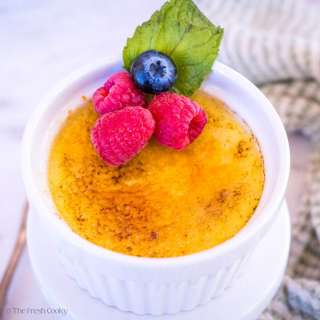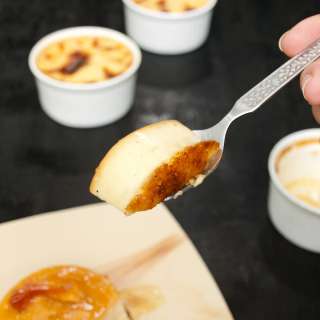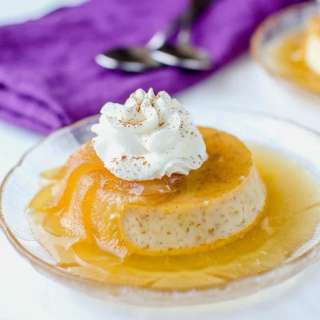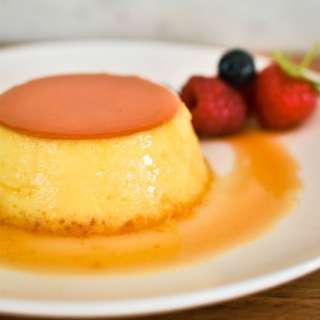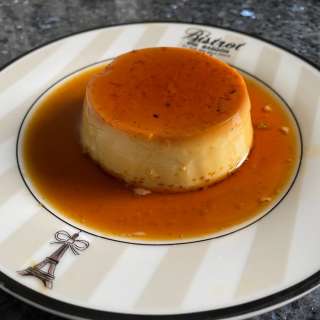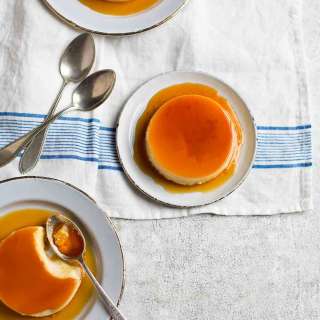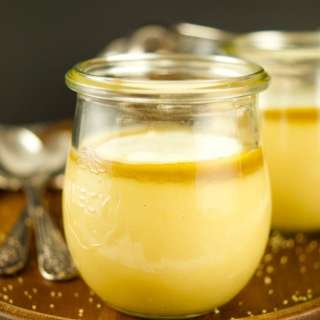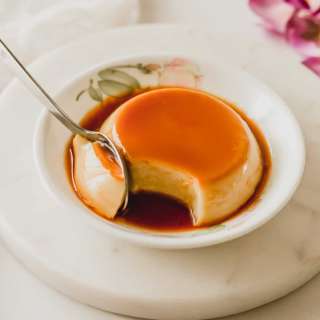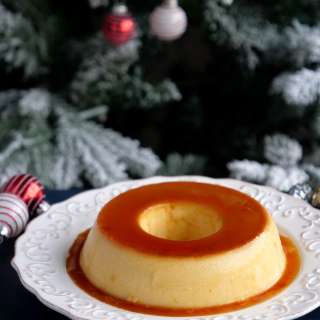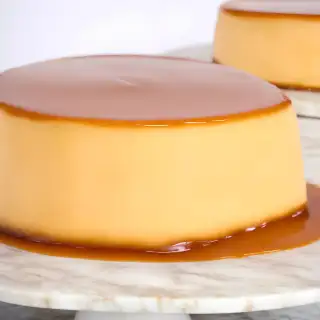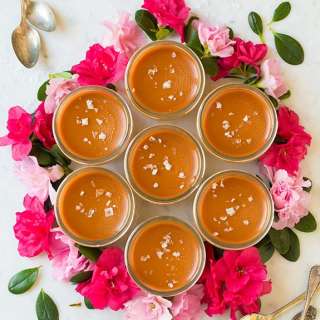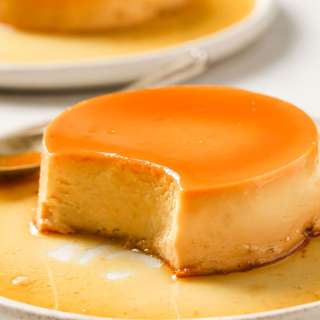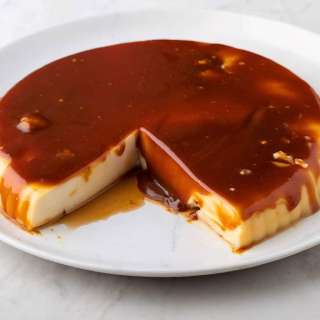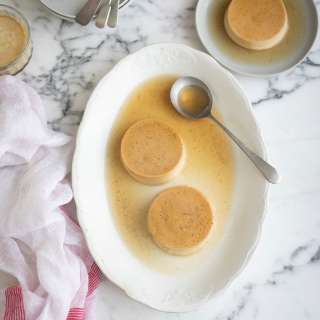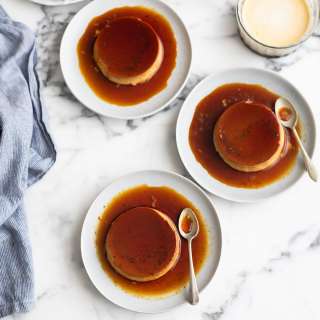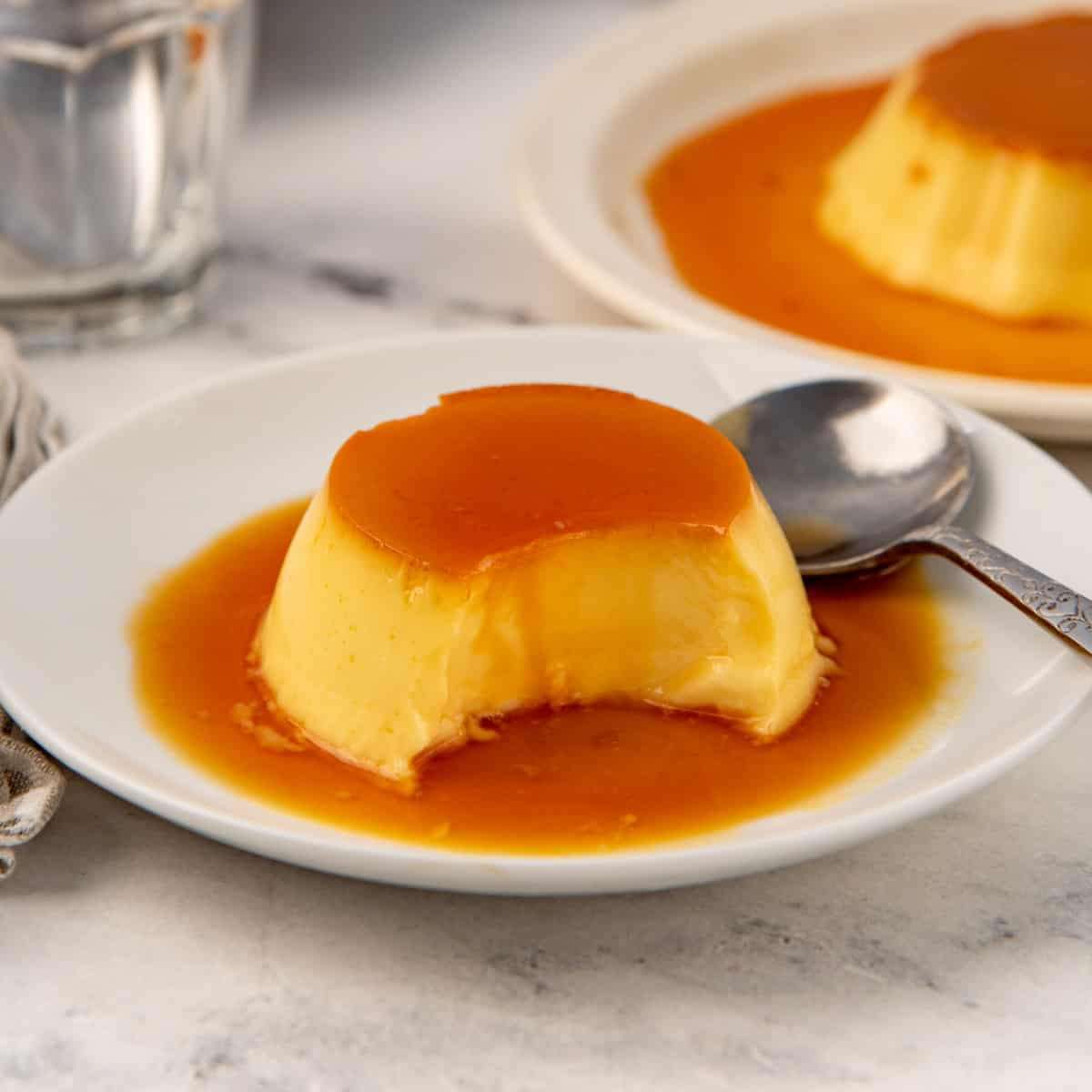
Easy Crème Caramel Recipe
User Reviews
5.0
9 reviews
Excellent
-
Prep Time
3 hrs
-
Cook Time
2 hrs
-
Additional Time
5 hrs
-
Servings
6 servings
-
Calories
234 kcal
-
Course
Dessert, Baked Goods

Easy Crème Caramel Recipe
Report
This silky smooth, irresistibly creamy, delicious Crème Caramel is such a simple dessert to make, with impressive results! A milky custard, and a lovely caramel flavor, with just a hint of bitterness, this classic French dessert is always a crowd favorite!EASY - This recipe is very easy. With all the information provided, you can adapt the recipe to make individual portions or one large portion as well. Makes about 6 or 7 servings (baked in ½ cup / 4 fl oz individual cups), or up to 8 people with a single large baked custard.This recipe contains an overnight chill time, so plan accordingly.
Share:
Ingredients
For the caramel
- 120 g white sugar ⅔ cup
- 3 tbsp water optional
- 2 tbsp corn syrup optional
For the custard
- 500 mL whole fat milk 2 cups, substitute 250 mL / 1 cup of milk with 250 mL / 1 cup of heavy cream (optional; see recipe notes)
- 2 pieces of lemon peel or orange peel
- 2 whole eggs
- 3 egg yolks see recipe notes below for how to use only whole eggs
- 2 tsp vanilla extract or vanilla bean paste (see recipe notes)
- 100 g white sugar ½ cup
- ¼ tsp sea salt
Instructions
- For individual portions, wash and dry the baking dishes. If you’re using a larger dish to make one big pudding, wash and dry the dish as well. See recipe notes for the number of the portions you can make with this recipe. Here, I’m using 6 or 7, 4 oz baking cups.
- Preheat the oven to 350°F / 180°C.
- Prepare a large baking tray that you can use as a water bath. The ramekins / baking cups should be able to sit in the water bath with at least 1 inch space between them (they should not be touching). Place a kitchen towel at the bottom of the water bath tray. Set aside until you need it.
Making the caramel
- For this recipe, I make a dry caramel, as I find it easier to caramelize that way because the risk of recrystallization is lower. But you can also make a wet caramel as well.
- See recipe notes for wet caramel instructions. Water and corn syrup will be added to the sugar. The corn syrup helps to prevent crystallization.
- Place the sugar in a stainless steel skillet. The sugar should form a fairly thin layer on the base of the skillet for quick and even melting. Make sure the skillet is clean and dry before you add the sugar.
- Place the skillet over medium heat. Make sure not to leave the sugar unattended while you make the caramel.
- The sugar that is in contact with the bottom of the skillet will start to melt first. Use a silicone spatula to push the melted sugar aside, and gently shake the pan to evenly melt the rest of the sugar.
- As the sugar melts and is stirred, the caramel will turn a light yellow color and will form lumps of undissolved sugar.
- Remove the pan from the heat and stir the mixture and break up the lumps, until most of the sugar is dissolved.
- Return the caramel to the stove and cook the caramel while frequently stirring. The caramel will turn dark yellow and then a golden color. Finally, it will turn an amber color.
- As soon as the caramel turns amber in color, remove the pan from the heat and switch off the stove.
- VERY CAREFULLY pour the caramel into the ramekins (metal or porcelain). Only add enough caramel to coat the bottom of the baking dishes / cups. At most, 5 mm thick (just eyeball it). Make sure the caramel layer is smooth and doesn’t have any thick streaks.
- Set aside until the custard base is ready.
Custard
Infuse the milk
- The first step of making the custard is to infuse the milk (if needed). If using fresh vanilla beans, or adding the lemon peel, this step is necessary.
- Place the milk (and cream, if using) in a saucepan.
- Cut the vanilla bean in half and scrape off the caviar. Place the caviar and the vanilla bean in the milk mixture. Also add the lemon peel in the milk, if using.
- Heat the milk over medium heat, while stirring occasionally. Heat until the milk is steaming, or is at a light simmer.
- As soon as the milk is heated, remove it from the stove and let the milk infuse for at least 30 minutes.
- When the milk temperature comes down to about 160°F / 71°C or lower, it's ready to be used.
- This step can be done first, and the caramel can be made while the milk is infusing as well.
Making the custard base
- If the milk does not need to be infused, heat the milk until it’s just starting to steam over medium heat. This will be about 150°F / 65°C.
- Remove the milk from the heat and set aside.
- In a large jug or bowl, place the eggs and egg yolks, vanilla extract (if you’re not using vanilla beans), salt, and sugar.
- Whisk until the eggs are mixed very well and the mix is slightly frothy. There should be no egg lumps in the mixture.
- Temper the eggs with the warm milk mixture (infused or not infused). This is done by streaming the hot milk very slowly into the egg mixture while constantly whisking the egg mixture. If the warm milk is added too fast or not mixed well, it could scramble the eggs - so add the milk slowly, a little at a time.
- Once the egg mixture has warmed up to almost the same temperature as the milk, the eggs have been tempered.
- Add the tempered egg mix into the remaining milk in the saucepan, and whisk to combine. Now you have the custard base.
- Strain the custard base using a sieve, into a jug. This will remove any lumps, and vanilla beans and lemon peel. The jug will make it easier to pour the custard into the baking dishes.
Baking the crème caramels
- Carefully pour the warm custard into the baking ramekins with the caramel layer at the bottom.
- Place the baking dishes in the water bath tray, on top of the kitchen towel. This will prevent any slipping. Have a piece of aluminum foil ready to cover the baking dishes as well.
- Place the water bath baking tray with the creme caramel ramekin / ramekins inside the preheated oven. Carefully pour very hot water into the water bath tray, so that the water comes about halfway up the ramekins.
- Cover with foil, and poke holes in the foil for the steam to escape.
- Bake the creme caramels until the custard is set. This will take about 30 minutes for 4 oz portions, and up to 60 minutes for larger portions. Check the dishes after 20 minutes, and every 5 - 10 minutes afterwards.
- The custard should set, but look wobbly in the middle. The best way to tell when the custard is done is to check the internal temperature of the custards. When the internal temperature registers at 175 - 176°F / 79 - 80°C, the custard is perfectly cooked.
- Remove the baking tray from the oven and carefully remove the ramekins from the water bath and let them cool to room temperature.
- Then transfer the ramekins to the fridge and let them chill overnight, or for at least 6 hours until they are completely chilled.
Serving
- Release the edges of the custard in the ramekins by using a thin blade to run it along the edge of the custard. Or you can use clean fingers to gently push the custard to release it from the sides of the ramekin.
- Then place the ramekins in very hot water (hot tap water is fine), for a few seconds to loosen the creme caramel. Alternatively, you can use a kitchen blow torch on the outside of the ramekins.
- Finally, place the serving plate over the ramekin and flip them both over, while holding them together.
- Firmly shake the ramekin a few times (NOT back and forth, just a sudden sharp shake downwards should do the trick), to help release the creme caramel from the ramekin. You will hear a plop sound when the custard is released.
- Serve immediately as is. You can also serve it with a dollop of whipped cream.
Notes
- I have made this recipe in 4 fl oz cups, 6 fl oz cups, and in 8 x 4 inch loaf pans for a larger pudding. The baking times will vary depending on the material of the baking dish and the starting temperature of the custard.
- If the custard base is warm to start with, then these are the approximate baking times.
- Substitute half of the milk with heavy cream, or use 10 % fat cream (table cream or half and half).
- Instead of 2 eggs and 3 egg yolks, use 4 or 5 whole eggs. For every cup of dairy, use 2 - 2.5 eggs.
- By weight, For every 500 mL or grams of dairy, use 190 - 220 g whole eggs.
- Once the crème caramels are baked, they can be left in the fridge for up to 4 - 5 days. But they are best eaten the day after they are baked.
- Leftovers can also be stored for about 3 days (provided it was baked only up to 2 days prior). Keep the pudding in an airtight container, and avoid prolonged temperature fluctuations.
- 4 oz metal ramekins = 25 - 30 minutes
- 6 oz metal ramekins = 30 - 35 minutes
- 6 oz porcelain ramekins = 30 - 37 minutes (depends on the shape of the ramekin).
- Loaf pan (roughly 35 square in area size) = 50 - 60 minutes. The custard layer is about 1.5 in thick. The thinner the custard layer, the faster it will bake in the oven.
- Place the sugar, water, and corn syrup in the pot. Make sure the pot has a lid that fits as well. Gently stir the ingredients to fully saturate the sugar with the water.
- Place the pot over medium heat and heat until the water comes to a boil and the sugar dissolves. DO NOT stir the water-sugar mixture. Instead, swirl the pot gently to help dissolve the sugar as the water heats up.
- When the sugar syrup comes to a boil, place the lid on the pot. Lower the heat a little and let it simmer for about 2 minutes. The goal of this step is to use the water condensation to wash the sugar crystals on the side of the pot back into the sugar mixture.
- You can also use a clean pastry brush that is dipped in cold water to brush the sides of the pot, to re-dissolve the sugar crystals into the sugar syrup.
- Once the sugar crystals on the side of the pot have been re-dissolved, allow the sugar syrup to continue to cook until it turns into caramel.
- Swirl the pot to evenly heat and cook the sugar syrup. The sugar syrup will be clear at first, and then the bubbles will become larger, and the syrup will start to turn light yellow in color.
- Continue to cook until the caramel turns an amber color. Remember to swirl the pot to evenly caramelize the sugar syrup.
- Pour the caramel into the baking dishes as per the recipe.
Nutrition Information
Show Details
Serving
0.5cup
Calories
234kcal
(12%)
Carbohydrates
38g
(13%)
Protein
6g
(12%)
Fat
7g
(11%)
Saturated Fat
3g
(15%)
Polyunsaturated Fat
1g
Monounsaturated Fat
2g
Trans Fat
0.01g
Cholesterol
162mg
(54%)
Sodium
155mg
(6%)
Potassium
162mg
(5%)
Sugar
38g
(76%)
Vitamin A
348IU
(7%)
Calcium
126mg
(13%)
Iron
1mg
(6%)
Nutrition Facts
Serving: 6servings
Amount Per Serving
Calories 234 kcal
% Daily Value*
| Serving | 0.5cup | |
| Calories | 234kcal | 12% |
| Carbohydrates | 38g | 13% |
| Protein | 6g | 12% |
| Fat | 7g | 11% |
| Saturated Fat | 3g | 15% |
| Polyunsaturated Fat | 1g | 6% |
| Monounsaturated Fat | 2g | 10% |
| Trans Fat | 0.01g | 1% |
| Cholesterol | 162mg | 54% |
| Sodium | 155mg | 6% |
| Potassium | 162mg | 3% |
| Sugar | 38g | 76% |
| Vitamin A | 348IU | 7% |
| Calcium | 126mg | 13% |
| Iron | 1mg | 6% |
* Percent Daily Values are based on a 2,000 calorie diet.
Genuine Reviews
User Reviews
Overall Rating
5.0
9 reviews
Excellent
Other Recipes
You'll Also Love
Cinnamon Crème Caramel (with Poached Apple)
European, American, Canadian, gluten-free
5.0
(6 reviews)
